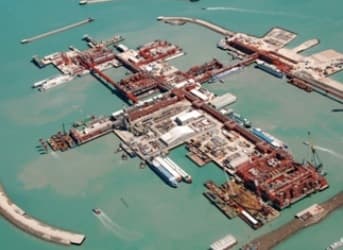Kazakhstan’s political elites are coming under enormous pressure, as the government – in power since the country declared independence in 1990 – faces yet another obstacle in the development of its massive Kashagan oil field.
The oil field is believed to contain 13 billion barrels of crude oil, and it has been under development by a consortium of energy giants that includes Exxon Mobil, Royal Dutch Shell, Total, Eni, and Kazakh state oil and gas firm KazMunaiGaz. Initial production at Kashagan was expected to be 180,000 barrels per day (bpd), with peak production reaching 1.66 million bpd – output that would rival that of Angola, a member of OPEC.
But the project has long been beset by problems. Kashagan has been delayed multiple times in the last five years, with production finally beginning in September 2013, only to be stopped again when gas leaks were discovered in the pipelines. The government of Kazakhstan has imposed a $737 million fine on the consortium in reaction to these leaks.
The project is difficult to manage due to weather conditions, which include ice encasing the oilfield for large portions of the year, and the presence of corrosive hydrogen sulphide in the natural gas that surrounds the oil project, making access difficult. These factors help to explain why the project is now $30 billion over budget. Total said earlier this month that Kashagan will not likely produce oil in 2014. It was initially expected to produce 22 million barrels of crude by the end of this year, according to estimates by Kazakh government officials.
Related Article: How Will the Crimea Debacle Affect $170 Billion FDI Investment in Kazakhstan?
The Kazakh government, based in Astana, has announced it intends to increase oil production by 2.5% via other projects, or 1.7 million bpd.
All this spells potential disaster for Kazakhstan, which has no substantial economic driver outside of its oil fields. The economy of the country – the size of Western Europe in area though only home to a scant 17 million people – remains dependent on its energy output, and the repeated delays and technical challenges of developing Kashagan only makes its economic profile weaker. Continued disputes between Astana and the consortium – which include bitter tax fights, fines for environmental damage, and damaged relations – also place a black mark on the country’s reputation for foreign investment.
Astana has attempted to launch a multitude of programs to diversify its economy away from dependence on natural gas and oil, but to limited effect. It remains unclear what, if any, positive impact the country has accrued from being a part of the Eurasian Economic Union, a trade organization between Kazakhstan, Russia, and Belarus, while other areas of potential growth, such as mining, have also faced impediments which include disputed subsoil rights with Russia’s Uranium One and environmental levies against Hambledon Mining.
Keeping the economy growing and elevating Kazakh citizens’ standard of living is a critical component of the electoral equation that allows long-serving President Nursultan Nazarbayev to remain in power. Nazarbayev vowed to improve Kazakhstan’s economic standing in return for a delay in democratic development. But growing inequality between the ruling class and ordinary Kazakh citizens is beginning to cause cracks in the foundation of this arrangement.
The biggest protests seen in Nazarbayev’s Kazakhstan occurred in 2011, when workers in the oil town of Zhanaozen went on strike demanding better wages. This strike went on for months, while government officials and oil chiefs continued to ignore the protesting workers.
Related Article: Geopolitical Turmoil Takes its Toll on ExxonMobil
Tensions between the government and the oil workers reached a boiling point on December 16, 2011, when protesters gathered in the town square during the country’s Independence Day celebrations. The situation quickly deteriorated, with police opening fire and shooting through the crowd, killing 14. The Nazarbayev regime was rattled to the core. The dictator fired his supposed heir and son-in-law Timur Kulibayev, the head of Kazakhstan’s sovereign wealth fund which oversaw the project. Numerous protesters were put on trial and several opposition leaders were detained.
Now with Kashagan on the rocks, Russia invading Ukraine, and Kazakhstan’s economic future uncertain, Astana has once again cracked down on freedom of expression, this time with an emergency media law. The law stipulates that once a state of emergency has been declared in the country, all media outlets – which includes newspapers, radio stations, and television channels – must hand over all texts to local government officials a full 24 hours before they’re published or broadcast.
Media which is found to be ‘offending’ can be suspended, according to the new regulation, which went into effect April 12.
ADVERTISEMENT
The new regulation also enables the Kazakh government to suspend political parties and public associations, ban the use of photocopy machines and broadcast equipment, impose a curfew, and ban the sale of firearms.
It would appear that the Kazakh government is bracing for the worst. Foreign investors and security analysts should take heed.
By Jacqueline Côté


















